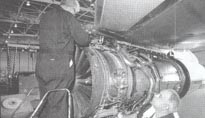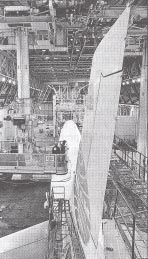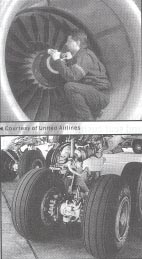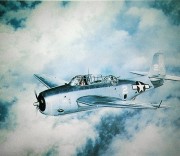|
AERONAUTICS
[In keeping with Aerosphere´s pledge to “...search the globe for the best articles and images...” we offer the following article by a U.S. Aviation Safety Inspector on the intricacies of a Boeing 747 inspection , which originally appeared in the September 8, 1999, edition of AWAKE! magazine and was refered to us by one of our readers. We reprint it here with permission.--Ed.]
747 “D” Inspection
One 747-200 had accumulated 36,000 hours in eight years when it hit the hangar for a “heavy” checkup, also called a “D” inspection.
The big D is a really big deal that can take up to a month or more and cost upwards of $2 million. See what it takes for this Boeing behemoth to get a clean bill of health.
What Does It Take To Keep Them Flying?
Ladies and gentlemen, welcome to New York City's John F. Kennedy Internation al Airport." That announcement to arriving passengers marks the beginning of a flurry of activity in and around the aircraft as its occupants leave. Have you ever wondered what happens to the plane at this point?
Commercial aircraft make money only while flying passengers or cargo, not while sitting on the ground. Therefore, airlines aim for the highest possible utilization of their fleets. As passengers wait for their baggage, the aircraft is being swiftly prepared for the next flight. Mechanics swing into action by reviewing the aircraft log for any mechanical problems noted by the last flight crew. Any matters affecting the safe operation of the plane, also called nogo items, are corrected.
The aircraft's wheels, tires, brakes, and engine oil levels are checked. Cleaning crews tidy up the passenger cabin. The kitchen units, or galleys, are resupplied with food and beverages. Fuel is pumped into the wing tanks. Before the aircraft is again ready for departure, the flight crew performs an exterior walkaround inspection, checking for any conditions that might compromise safety.
This turnaround service and immediate maintenance is performed on thousands of aircraft every day. But that is only a tiny fraction of what it takes to keep a large passenger plane safe to fly. Just as automobiles need periodic servicing, airplanes regularly require a series of extensive and expensive maintenance checks. Who perform these aircraft maintenance services? How is the work carried out?
How the Planes Are Kept Airworthy
According to the U.S. Air Transport Association, member airlinescarry more than 95 percent of the air traffic, both passenger and freight, in the United States. In 1997 those airlines had about 65,500 aircraft mechanics on the job. Along with engineers and other maintenance personnel, the aircraft mechanics' mission is to keep the aircraft airworthy and to ensure passenger comfort. That means inspecting, repairing, and overhauling the multitude of specialized parts —the machines within the machine—that make an airplane fly. * Such scheduled maintenance includes everything from overhauling jet engines weighing over four tons to replacing wornout cabin carpets.
* A 747-400 has six million parts, half of which are fasteners (rivets and bolts), and 171 miles of electrical wiring.
Most mechanical problems get immediate attention. However, the aircraft maintenance program schedules other maintenance on the basis of the number of months the aircraft has been in use or the number of cycles# and the number of hours each aircraft has flown, not on the total number of miles it has flown. The program begins with maintenance recommendations made by the aircraft manufacturer to the airplane operators, which must be acceptable to government aviation authorities. Each aircraft has its own tailored maintenance program, from light to intermediate to heavy checks. These checks are designated by letters, such as A, B, C, D, L, or Q.
(# A cycle equals one takeoff and landing)
One 747200 took about eight years to accumulate some 36,000 hours of flying time. When it did, it was time to head to the hangar for a heavy check, sometimes called a D check. Commenting on this complex and time consuming check, Overhaul & Maintenance, an aviation management magazine, says: "The goal . . . is to, as much as possible, return an entire airframe to its original condition….I
A D check takes between 15,000 and 35,000 hrs. of labor, and can put a plane out of service for 15 to 30 days, or more. The total cost averages between $1 million and $2 million." "A typical D check is 70% labor and 30% material," said Hal Chrisman of The Canaan Group, an aerospace management consulting firm. Of course, some of that cost is included in your airline ticket.
What a D Check Involves
Once the aircraft is parked inside the hangar—a huge complex of aircraft service areas, support shops, and warehouses—the maintenance team goes to work. Worktables, platforms, and scaffolds are rolled into position for access to otherwise unreachable areas of the plane. Seats, floors, walls, ceiling panels, galleys, lavatories, and other equipment are opened or removed from the aircraft to permit close inspection. The aircraft is essentially gutted. Following step-by-step instructions, workers examine the aircraft for signs of metal cracks and corrosion. Whole sections of the aircraft’s landing gear, hydraulic system, and engines may be replaced. The D check requires the skills of engineers, technical writers, quality control inspectors, avionics technicians, * sheet-metal workers, and airframe and power-plant mechanics, ** most of whom are government licensed. When cabin equipment mechanics, painters, and cleaners are added, the number of personnel swells to well over 100 per day. Scores of others provide essential equipment, parts, and logistics support.
* “Avionics” is an abbreviation for aviation electronics.
**The airframe and power-plant certificate allows mechanics to approve flight work that he or she has performed on airplane structures, systems and engines.
Over time, inflight vibrations, fuselage pressurization cycles, and the jolts of thousands of takeoffs and landings cause cracks in the metal structure of the aircraft. To address this problem, aviation employs diagnostic principles similar to those used in the field of medicine. Both use such tools as radiology, ultrasonics, and endoscopy to detect what the human eye cannot see.
For a conventional medical X ray, the patient is placed between a sheet of film and an Xray beam. To Xray the landing gear, wings, and engines, maintenance inspectors use similar methods. For example, a sheet of Xray film is placed at a desired point on the engine exterior. Next, a long metal tube is placed inside the hollow shaft that runs the length of the engine. Finally, a pill of radioactive iridium 192—a powerful isotope—no bigger than a pencil eraser, is cranked into the tube to expose the Xray film. The developed film helps to reveal cracks and other flaws that may require that the engine be repaired or replaced.
During the D check, samples of the aircraft's fuel and its hydraulic fluids are sent for laboratory analysis. If microorganisms are found in the fuel sample, antibiotics are prescribed. To kill jet fuel bugs—fungi and bacteria that can get into fuel tanks through the air, water, and fuel—the tanks are treated with a biocide, a form of antibiotic. This treatment is important because the byproducts of microbial growth can corrode the protective coatings on the surface of the tanks. Fuel probes in the tanks can also be affected and thus cause the pilots to receive inaccurate fuel gauge readings.
As a result of normal wear, vibrations, and internal seal damage, fuel tanks can develop leaks. A supervisor asks his assembled D check crew, "Does anyone want to be a 'frogman'?" The joyless but necessary chore falls to John. Looking somewhat like a scuba diver without flippers, he dons special cotton coveralls, puts on a respirator connected to a fresh air supply, and takes tools, sealant, and a safety light with him. Through a small opening in the bottom of the wing, he squeezes his way into the defueled wing tank, locates the source of the fuel tank leak, and seals it.
Built into the wings of the plane, the fuel tanks of a 747 are a maze of walled compartments connected by small openings. Fuel tanks are no place for the claustrophobic. A 747400 can hold more than 57,000 gallons of fuel. This fuel capacity makes it possible to fly extremely long routes nonstop, such as from San Francisco, California, U.S.A., to Sydney, Australia—a distance of 7,400 miles.
Three stories above the ground on the flight deck, an avionics technician inspects a builtin testpattern display on the TVlike weather radar indicator screen. Pilots use this instrument to detect and avoid thunderstorms and turbulence that may be as far as 300 miles ahead of the airplane. So when the pilot turns on the "Fasten Seat Belt" sign, he may have seen turbulence on his radar screen. However, to prevent injuries, many airlines request that when seated, passengers keep their seat belts fastened at all times, even if the captain turns off the sign. Atmospheric changes in the form of clearair turbulence are often encountered before pilots have time to turn it on.
During the D check, safety equipment, such as life vests and emergency lighting, is checked or replaced. When a check of the passenger emergency oxygen system is under way, oxygen masks dangle like oranges on branches. Jet airplanes routinely cruise at altitudes of four to seven miles above the earth, where the oxygen content and the atmospheric pressure are insufficient to sustain life. How is this problem solved? The aircraft's pressurization system draws in outside air and then compresses it. This air is finally supplied to the cabin at an acceptable temperature. If the air pressure in the cabin falls below safe levels, oxygen masks automatically drop from overhead compartments. The emergency oxygen is supplied to the passengers until the aircraft descends to an altitude where the emergency oxygen is no longer needed. On some airplanes, oxygen masks are stowed in passenger seatback compartments, not in overhead compartments. That is why it is important to pay attention to preflight passenger briefings, which identify the location of the oxygen masks.
A heavy maintenance check is also the time to install new cabin walls and ceiling panels as well as to replace carpets, curtains, and seat cushion covers. Galley equipment is disassembled, cleaned, and sanitized.
Ready to Fly
After 56 days of inspections, checks, repairs, and maintenance, the aircraft is ready to leave the hangar and resume flying passengers and cargo. Only a small fraction of the maintenance operations have been mentioned here. But before flying again, the aircraft may be test flown by a special crew to ensure that all systems function properly. It is reassuring to consider briefly how much expertise and technology go into keeping the aircraft that you fly in mechanically sound.
However, the best single tool in aircraft maintenance is said to be the human element —sharp eyes and alert minds. The trained personnel take their jobs very seriously. They know that poor maintenance can cause big problems. Their goal is to provide reliable aircraft that will speed you to your destination safely and comfortably--contributed by a U.S. aviation safety inspector.
|







